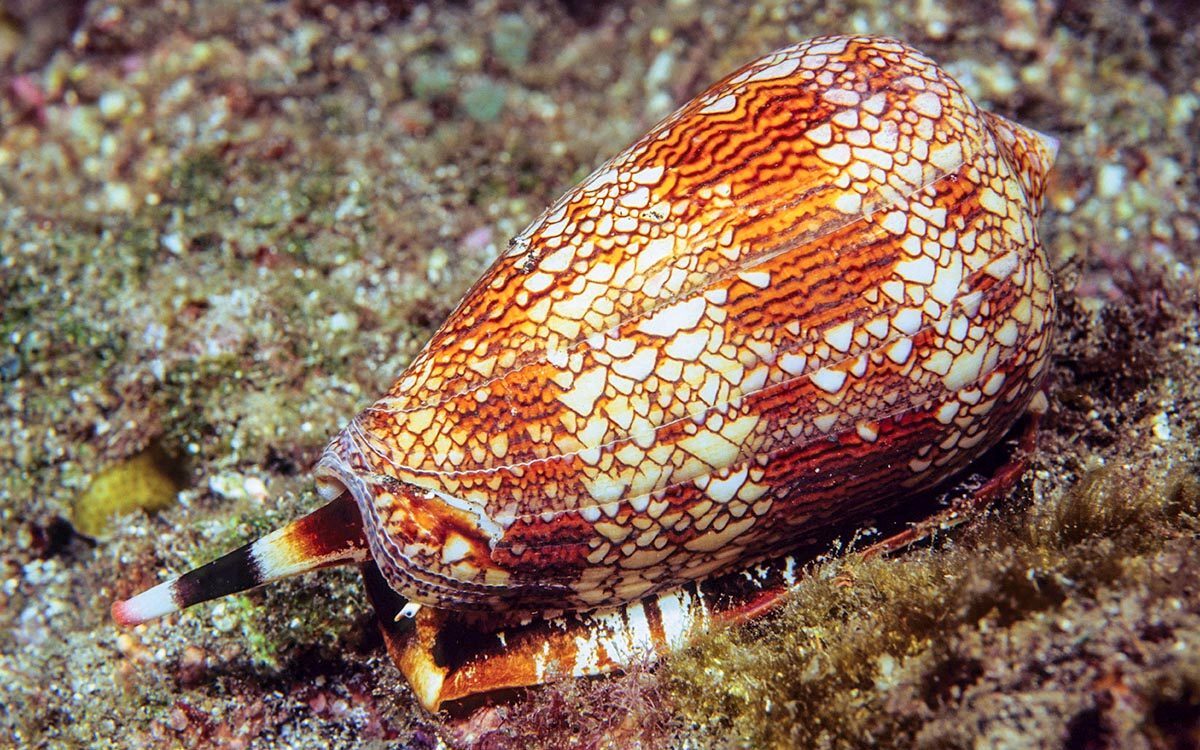
Cone snails might look harmless with their beautiful, patterned shells, but these sea creatures pack a punch. Found in warm tropical waters, they are both fascinating and dangerous. Did you know that a single drop of their venom can be lethal to humans? Cone snails use a harpoon-like tooth to inject venom into their prey, paralyzing them almost instantly. Despite their deadly nature, scientists study their venom for potential medical breakthroughs, including painkillers. Intrigued? Let's dive into 35 captivating facts about these remarkable snails, from their unique hunting methods to their surprising contributions to science. Get ready to be amazed!
Key Takeaways:
- Cone snails are beautiful but deadly marine creatures with potent venom. Their hunting techniques, venom potency, and conservation status make them fascinating and important to protect.
- Despite their danger, cone snails have surprising behaviors and adaptations, such as changing shell colors and using their sense of smell to hunt. They play a crucial role in marine ecosystems and hold potential for medical research.
What is a Cone Snail?
Cone snails are fascinating marine creatures known for their beautiful, cone-shaped shells and potent venom. Found in tropical and subtropical seas, these snails are both mesmerizing and dangerous.
- Cone snails belong to the family Conidae, which includes over 800 species.
- They are primarily found in the warm waters of the Indian and Pacific Oceans.
- Their shells are often brightly colored and patterned, making them popular among shell collectors.
- Despite their beauty, cone snails are highly venomous and can be deadly to humans.
How Do Cone Snails Hunt?
Cone snails are carnivorous predators that use a unique hunting method to capture their prey. They rely on their venomous harpoon-like tooth to immobilize and kill.
- Cone snails use a specialized radula tooth to inject venom into their prey.
- Their venom contains a complex mixture of toxins that can paralyze fish, worms, and other small marine animals.
- Some species of cone snails can extend their proboscis to catch prey from a distance.
- They are known to hunt at night, using their keen sense of smell to locate prey.
The Potency of Cone Snail Venom
The venom of cone snails is one of the most potent in the animal kingdom. It has both medical and scientific significance due to its unique properties.
- Cone snail venom contains conotoxins, which are small peptides that target specific receptors in the nervous system.
- The venom can cause paralysis, respiratory failure, and even death in humans if not treated promptly.
- Despite its danger, cone snail venom is being studied for its potential use in pain management and other medical applications.
- A single drop of cone snail venom can be lethal to 20 humans.
Cone Snail Reproduction and Lifespan
Understanding the reproductive habits and lifespan of cone snails provides insight into their survival and propagation in the wild.
- Cone snails are oviparous, meaning they lay eggs.
- Female cone snails can lay hundreds of eggs at a time, which hatch into free-swimming larvae.
- The larvae undergo several stages of development before settling on the ocean floor and transforming into adult snails.
- Cone snails can live up to 20 years in the wild.
Interesting Facts About Cone Snails
Beyond their venom and hunting techniques, cone snails have several other intriguing characteristics that make them unique.
- Cone snails have a siphon, a tube-like structure they use to breathe and detect prey.
- They are slow-moving creatures, relying on stealth and surprise to catch their prey.
- Some species of cone snails can grow up to 23 cm in length.
- Cone snails have been around for millions of years, with fossil records dating back to the Eocene epoch.
Cone Snails and Human Interaction
Human interaction with cone snails can be both beneficial and dangerous. While their venom holds medical promise, encounters can be fatal.
- Shell collectors often seek out cone snails for their beautiful shells, sometimes risking their lives in the process.
- There have been documented cases of cone snail stings causing fatalities in humans.
- Cone snail venom is being researched for its potential to treat chronic pain, epilepsy, and other neurological disorders.
- The peptide ziconotide, derived from cone snail venom, is used as a painkiller for severe chronic pain.
Conservation Status of Cone Snails
The conservation status of cone snails is a growing concern due to habitat destruction and over-collection.
- Some species of cone snails are considered vulnerable or endangered due to habitat loss and overfishing.
- Conservation efforts are underway to protect their natural habitats and ensure their survival.
- Marine protected areas help safeguard cone snail populations from over-collection and environmental threats.
- Public awareness campaigns aim to educate people about the importance of conserving cone snails and their habitats.
Fun and Surprising Facts About Cone Snails
Cone snails continue to surprise scientists and enthusiasts with their unique behaviors and adaptations.
- Cone snails can change the color of their shells to blend in with their surroundings.
- They have a highly developed sense of smell, which they use to detect prey and potential mates.
- Some species of cone snails can "spit" their venomous harpoon to catch prey from a distance.
- Cone snails are solitary creatures, often found hiding under rocks or buried in sand during the day.
- Their venom is so potent that it can kill a fish in less than a minute.
- Cone snails have a unique way of moving, using a muscular foot to glide across the ocean floor.
- Despite their deadly venom, cone snails play a crucial role in marine ecosystems by controlling the population of their prey.
The Final Sting
Cone snails, with their beautiful shells and deadly venom, are fascinating creatures of the ocean. These marine mollusks pack a powerful punch, using their harpoon-like teeth to deliver venom potent enough to paralyze fish and even humans. Despite their dangerous nature, cone snails contribute significantly to scientific research, particularly in the field of pain management. Their venom contains compounds that could lead to new, non-addictive painkillers.
Understanding these creatures helps us appreciate the delicate balance of marine ecosystems. While their venom is a marvel of evolution, it also serves as a reminder of the ocean's hidden dangers. Next time you encounter a cone snail, admire its beauty from a safe distance. These small but mighty snails are a testament to nature's complexity and the ongoing quest for medical breakthroughs. Stay curious, stay safe, and keep exploring the wonders of our natural world.
Frequently Asked Questions
Was this page helpful?
Our commitment to delivering trustworthy and engaging content is at the heart of what we do. Each fact on our site is contributed by real users like you, bringing a wealth of diverse insights and information. To ensure the highest standards of accuracy and reliability, our dedicated editors meticulously review each submission. This process guarantees that the facts we share are not only fascinating but also credible. Trust in our commitment to quality and authenticity as you explore and learn with us.


